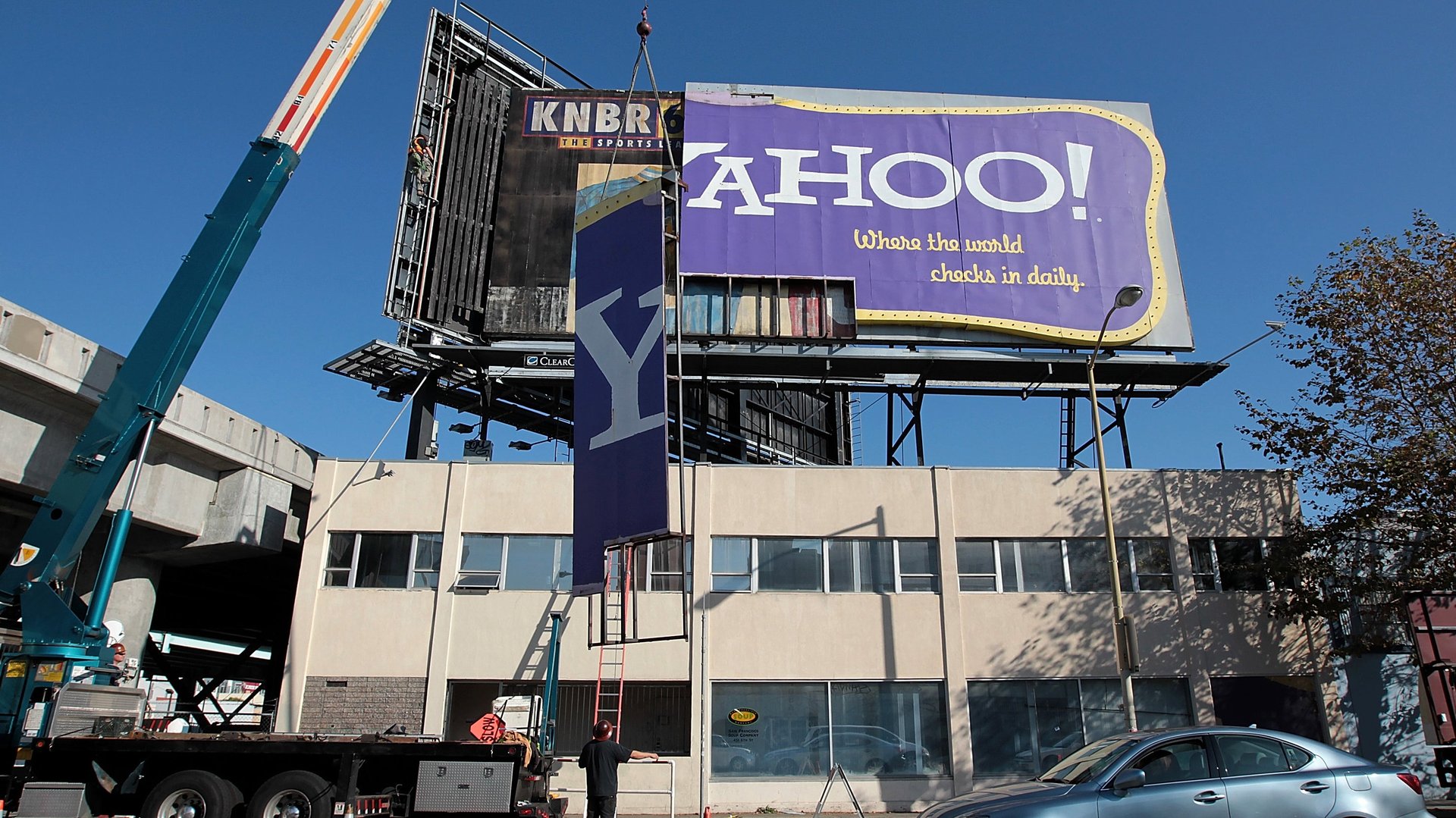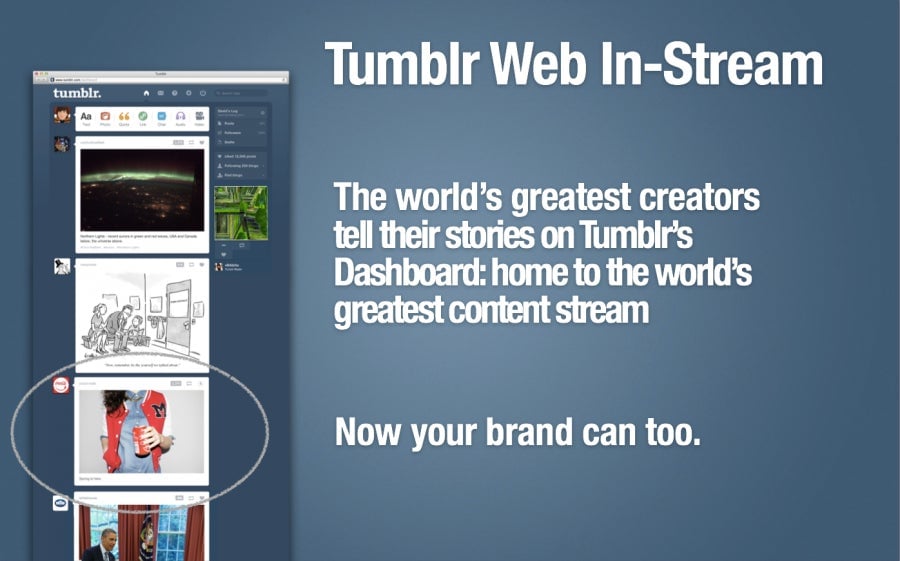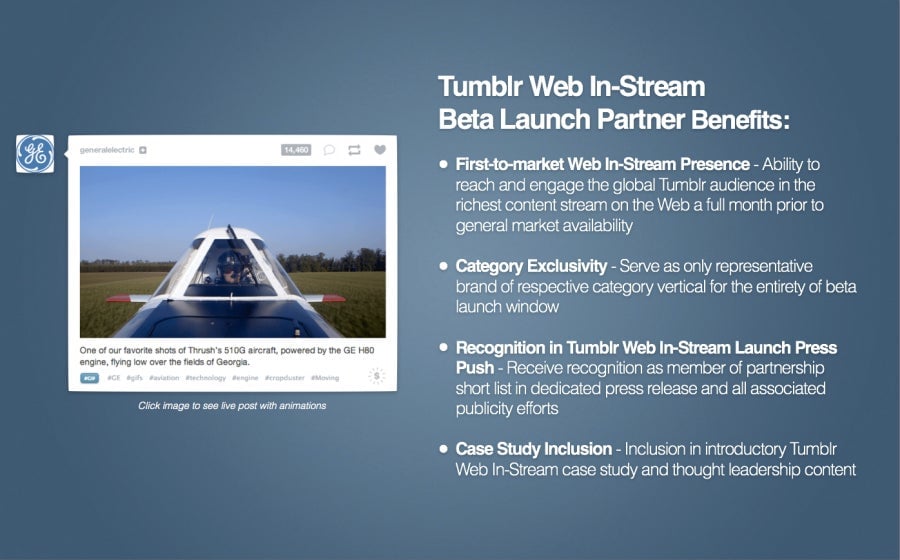How Yahoo plans to make money on Tumblr: ads that don’t feel like ads
“We’re pretty opposed to advertising,” David Karp, the founder of Tumblr, said three years ago. “It really turns our stomachs.” So today he’s turning over the six-year-old blogging startup to a company that can stomach it.


“We’re pretty opposed to advertising,” David Karp, the founder of Tumblr, said three years ago. “It really turns our stomachs.” So today he’s turning over the six-year-old blogging startup to a company that can stomach it.
Yahoo, which currently generates 76% of its revenue from advertising, made clear that it intends to make money from its $1.1 billion acquisition of Tumblr in the best way it knows how, with plenty of ads. Marissa Mayer, the CEO of Yahoo who personally negotiated the deal, described two types of advertising that will make its way to the site.
The first type is the least interesting: display ads on Tumblr blogs that opt to put them there. Yahoo would split the revenue with the blogger in a way similar to Yahoo Bing Network Contextual Ads and Google AdSense. Karp has made clear what he thinks of that: “We could very easily throw Google AdSense on and be profitable tomorrow, ” he said last year. “That’s so far down the list, I mean, we’re selling our desks to avoid that. It’s a complete last resort.”
Karp, who will remain in charge of Tumblr, is right to be skeptical. The price associated with such ads has been dropping steadily across the web, and Yahoo’s display ad revenue fell 11% last quarter from the same period a year earlier. Advertisers, meanwhile, are increasingly dismissive of the value of display ads in familiar boxes that people have been trained to ignore.
Observing those trends, Yahoo has already been experimenting with new types of ads, including much larger “billboards” on its popular homepage and “stream ads” that look like news updates but are written and paid for by a sponsor.
That second type of advertising is coming to Tumblr, too, Mayer said. In the ad business, the trendy name for it is “native advertising.” Native ads tend to make people’s heads hurt, but that’s generally because they’re thinking about it too hard.
On a platform like Tumblr, native ads are just regular old posts, except that they’re authored by a brand that pays for the privilege. Comedy Central, for instance, has one of the most popular blogs on Tumblr. Every time the television network posts something, that’s an ad for the brand, even if it’s not paying and most Tumblr users wouldn’t consider it advertising.
Platforms where anyone can post anything—like Tumblr, Twitter, Facebook, and other social networks—have a much easier time with native advertising than publishers like the Washington Post or Quartz, which feel an ethical obligation to distinguish between material written by their journalists and content produced by advertisers. (Quartz runs native ads labeled “Sponsor Content.”) On platforms, the distinction is already pretty muddled, there’s no professional content to privilege, and frankly users don’t care as long as the stuff is good.
Money comes into the picture when brands pay to get their stuff in front of people who aren’t already following them. That describes a lot of the advertising on Facebook and Twitter, and it’s exactly what Mayer said is coming to Tumblr, as well. Tumblr users will start to see blog posts on their “dashboards” from brands that are paying to be there.
Here’s a slide from the presentation Tumblr has been giving to advertisers it wants to the attract to the launch of these native “In-Stream Ads,” which will cost $200,000 for broad exposure on the site for about a month:

As with all other native advertising, Tumblr’s will succeed or fail based on whether users actually want to see it, which is another way of saying that the posts need to feel like they belong on Tumblr. Notice how Yahoo’s post on Tumblr announcing the acquisition made use of an animated GIF, a somewhat clumsy attempt to fit in on a service where animated GIFs are popular, but certainly better than a press release.
Creating high-quality native advertising is hard, which is why it wouldn’t be surprising if Tumblr also began to fashion itself as an ad agency, charging brands for advice on how to become the next Comedy Central on Tumblr. Indeed, the presentation to advertisers promises “best practices and content strategy support from the Tumblr team.” And there’s an animated GIF among the ad examples in Tumblr’s presentation:

Another advantage of native advertising is that it translates well onto mobile devices, where there’s little room for display ads but plenty of room for actual content. (In-Stream ads begin running on Tumblr’s website on June 1; they’re already running, in a limited form, in Tumblr’s mobile apps.) But the downside there is similar: With less room to work with, mobile native ads that are perceived as advertising will quickly grow tiresome, which is a problem Facebook has encountered. That makes it all the more important that Tumblr’s ads actually appeal to its users, and why the future of Yahoo’s advertising business—on Tumblr, at least—may be cats and animated GIFs.